


Addresses at these locations;
MANCHESTER: 199 Bury New Road
Whitefield
Manchester, M45 6GE. (UK).



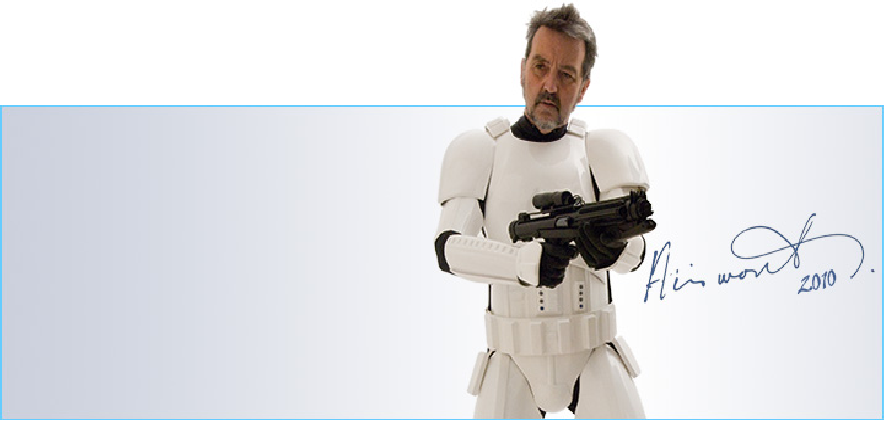
HOW IT ALL STARTED
We produced the originals for the first Star Wars ANH (A New Hope) film back in 1976 and are still producing fantastic products more than 30 years later. Read our story below!
GENUINE. AUTHENTIC. QUALITY.
One day a good friend of mine had an enquiry for a futuristic military character. He was a scenic artist and he had no concept of how to achieve armies of slick, three dimensional characters. He was, however, an excellent artist with an enviable outlook on life and with a common passion for motor cars. When he asked me if I could make him something workable, I didn't think twice..."Andrew Ainsworth talking about how he became involved in making the original props for ANH.
The Twickenham connection
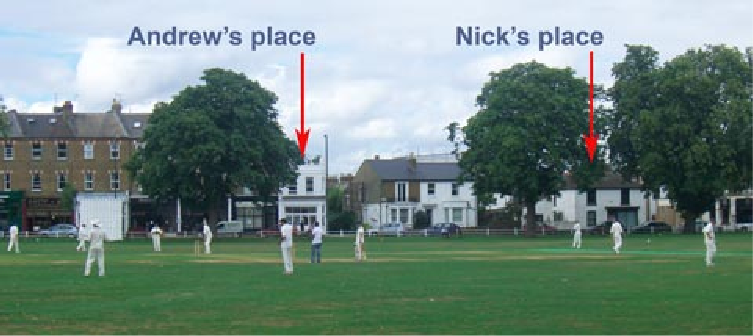
The Green, Twickenham, showing Andrew's and Nick's premises.
In 1976, Nick Pemberton, a successful scenic artist and puppeteer and Andrew Ainsworth, a recently qualified Industrial Designer from Ealing Art School, lived a couple of buildings apart on Twickenham Green, England. They both worked from their premises which were Victorian shops with out-
Twickenham is in an old part of South West London. It was an artistic and creative environment in which to work, surrounded by film and television studios, theatres, and famous landmarks which heralded the early days of rock music.
ANH first contact
Nick was approached by the Star Wars 'buyer' to make various helmets and ancillary items for the film. As Nick recalls, 'the film was just another no hoper'; he was also very busy at the time on a large puppetry job for Tyne Tees television in Newcastle.
Nevertheless he took the job on, with the intention of convincing Andrew to produce the characters as Nick was impressed with the plastic moulding techniques that Andrew was developing, just a couple of doors away (see image below).
Nick's diary states that at first, he only had contact with George Lucas, as at that early stage, there really wasn't anyone else -
This opinion is supported by Ralph McQuarrie`s (ANH Concept Artist) statement in an interview referring to the challenges of making the film, when he said that 'they would have the biggest problems making the Stormtroopers.' This sets the scene for Lucas' uphill battle to fulfil his dream...a fantastic achievement given the circumstances and lack of resources.
The prop makers brief
On 6 Jan 1976, Nick had a meeting with George Lucas to discuss the Stormtrooper helmet and other characters. John Mollo came on board about the same time. In his sketch book (page 213, 12 Jan 1976) it states discussing with Nick the Stormtrooper helmet, gun & holster, Jawa mask and Tuscan raider. In addition, there was a note to get a couple of samples from the USA -
Nick and his staff worked intermittently on Mollo's requests and Nick had a couple of further meetings with Lucas to discuss the direction it was all taking. Mollo had placed his hopes in Nick to produce the various helmets and allocated the Art Department at the Studios to start work on the Stormtrooper armour (Mollo’s sketch book, page 214).
Lucas chose Nick’s red clay Stormtoooper mock-
...Nick could now ask me to make the Stormtrooper a reality. Andrew Ainsworth
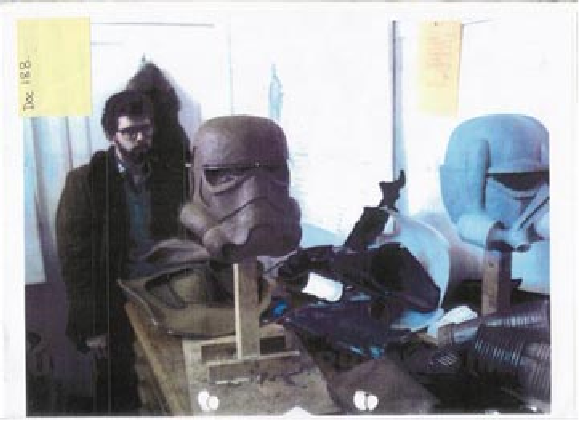
George Lucas viewing the Stormtrooper mock-
Lucas chooses...
By the 20 Jan, Nick was ready for his third meeting with Lucas at the Studios. He'd prepared a red clay mock-
Whilst Nick was on his guided tour, Lucas was inspecting the various alternatives that he had for the Stormtrooper head. The photo shows Lucas inspecting a grey helmet, as sculpted by Liz Moore at the Studios and beside it, the one Nick had presented in red clay. (Nick always used red clay as it was cheaper; the Studios' Art Department always demanded the best fine grey clay. Lucas chose the direction of Nick's effort and the Studios effort was abandoned.
Nick returned home with the go ahead from Lucas, even though he had no form of contract or order. Nick could now approach Andrew to turn the Stormtrooper helmet into reality...
"I made no sketches, no models, no engineering drawings .I sculpted the production moulds directly, using my own blends of resins, fillers, and metal dusts. The production moulds were the sculptures -
Andrew's task was to take his friend Nick's clay model and Ralph McQuarrie's concept drawings and sculpt the moulds which would form the iconic white plastic helmets worn by the Stormtroopers in ANH. Andrew recalls "The concept drawings from Ralph McQuarrie suggested that the Stormtrooper was a futuristic being that had evolved through continuous genetic modification, and perhaps able to operate in adverse pungent climatic conditions. The helmet would therefore be able to filter noxious gases and the armour be so flexible that it could have actually grown on the character that way -
It was obvious to Andrew that no joins or fabricated parts should be seen, the character should be homogeneous, and so the head must flow into the body and be undercut to disguise any suggestion of an actor inside the costume. The surface of the character was to be hard and protective, but flexible with a smooth, slick finish. The drawing suggested a silver, metallic look. Producing a prototype with all these features would be a challenge, given the non-
Vacuum forming
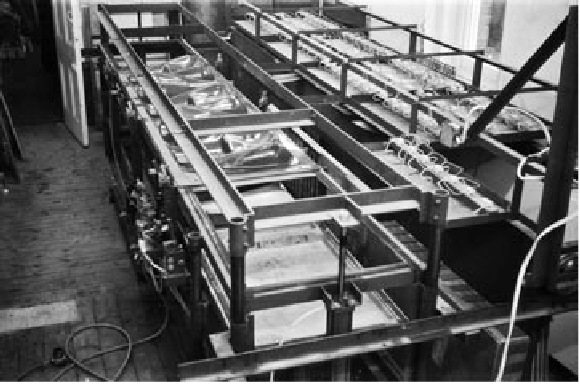
Andrew had established himself as an Industrial Designer, designing and manufacturing his own products. The use of plastics and composite materials was relatively new in 1976 and so Andrew built his own plastic moulding machinery (see right) to suit the size and type of products he designed.
His large 15ft long vacuum forming machine punched out plastic kayaks and fish ponds on a regular basis, and surprisingly enough it was located in the front of his Victorian sweet shop on the Green at Twickenham. The premises were tight for this sort of plant, and so finished mouldings were often stacked in front of the shop before shipping (see below).
Ingenuity
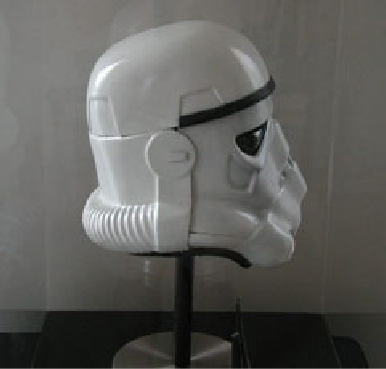
Prototype helmet incorporating split hose
Andrew's plastic kayaks incorporate a cunning feature that formed an undercut for the cockpit combing by leaving behind in the moulded part a pre-
Andrew’s first effort was to incorporate a flexible split hose around the neck of the helmet, suck the hot plastic over to form an undercut, leaving the hose back in the job every time (see left). This worked okay but it was slow and required complicated tooling.
By chance, at that time, Andrew was producing a line of fish ponds and rock cascades (see below), which were made of a khaki stone coloured HDPE (High Density Polyethylene) sheet material. This material is very tough and flexible, although difficult to mould without severe shrinkage and impossible to paint. Everything is a compromise in manufacturing and so Andrew decided that the characteristics of HDPE that would allow the mouldings to spring off undercuts would outweigh the shrinkage and painting problems -
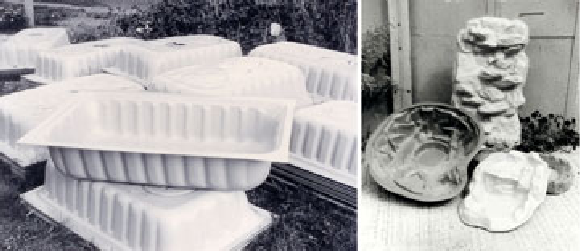
HDPE fishponds and rock cascades made by Andrew in 1976
In an ideal world the finished product should be manufactured without any seams or joins, and so rotational moulding process would probably be most suited. As this was restrictive on time and money, Andrew decided instead to sculpt an initial mould in two parts with the intention of producing the prototype with vacuum formed plastic mouldings joined together.
He could not use Nick`s mock-
The Original Mould
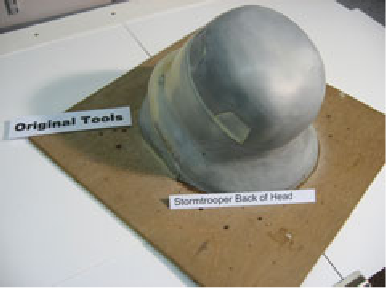
The two moulds had to produce finished plastic mouldings that could overlap to facilitate a fixing of the complete helmet. To achieve this they had to be sculpted independently of each other. The trick was to get them to a near state of fitting and continually vacuum form material over them, adjusting the sculpt each time until a satisfactory fit was achieved. Trial and error was the order of the day, a process that was also used to achieve the maximum undercut with the HDPE plastic sheet.
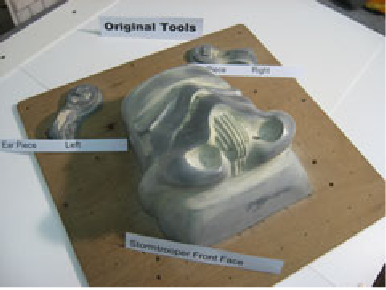
Through much experimentation, Andrew achieved a smooth surface on the moulds, (see pictures) and incorporated all the facial details required including a forehead location for assembly. The two halves of the helmet finally fitted reasonably well together although the symmetry had wandered somewhat due to the trial and error element of making the moulds.
A rubber trim, left over from Andrew's car production, fitted the forehead joint perfectly and another one finished off the bottom skirt of the helmet.
Blister eyes
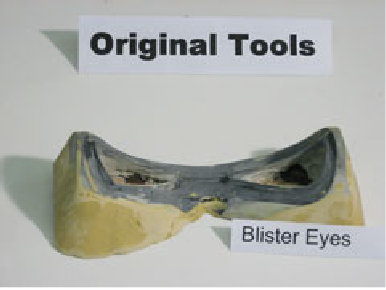
Tool for forming the blister eyes
The eyes were next. Surely any futuristic, finely tuned, military character would have significantly enhanced vision. It occurred to Andrew that "a 'fly' type of eye with more than just unidirectional vision would suit the bill". His first attempt was to make 'blister' eyes, by sucking cast acrylic sheet through a frame the shape of the Stormtrooper's eyes, resulting in a menacing eye that could also -
As helmet production progressed, several modifications were made. With the disorientated vision through the acrylic eyes, the actors kept falling over and bumping into things, and so a plain sheet of green acetate was used instead. The mic tips were initially quite a crude moulding and so these were tweaked a little too.
Ear moulding
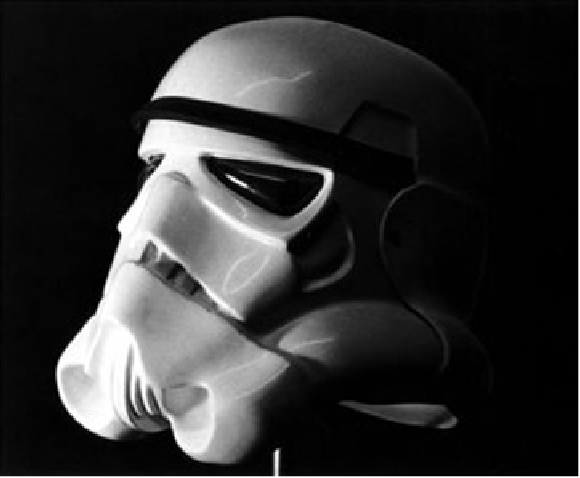
The helmet was beginning to come together...
The helmet was beginning to come together now (see picture) but it looked unbalanced and the join at the side was ugly. The character now had super multidirectional vision, the ability to function in noxious atmospheres, a super slick appearance. It was calling out for some sort of audio communication system.
Andrew constructed an ear moulding that not only suggested a radio-
The die was cast
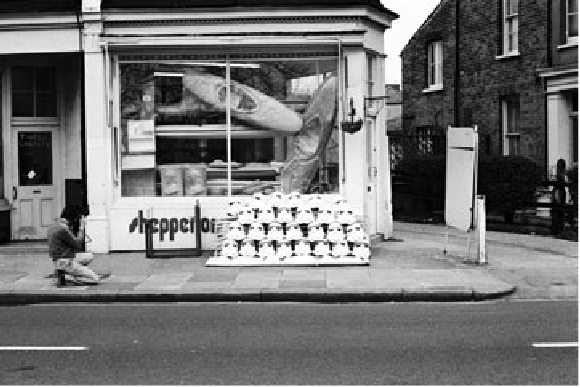
Andrew's Victorian sweet shop was not always large enough...
As Andrew reflects "There are many stages and processes along the way to make a movie. Many people’s efforts are edited out as the only thing that matters is the visual impact of the final piece and its 'fitness for purpose'." Andrew achieved this by his unconventional 'trial and error' method of sculpting and manufacturing which was ultimately successful in creating a helmet that Lucas preferred over any other. The die was cast! Now it was time to move from prototype to production...
Rebel and Imperial Brief
"After I made the initial Stormtrooper prototype I was introduced to John Mollo, Costumer Designer for the film. John was an excellent communicator. We had an empathy -
After a couple of long days working on the prototype, Andrew showed Nick the results and on the morning of 23 Jan 1976 John Mollo visited Nick to view the result. Nick then introduced Andrew to Mollo, who was obviously impressed with the work as he asked Andrew if he could also make 5 new helmets based upon the Navy helmet and helicopter pilot helmet which he had brought with him.
Nick's diary records that on 29 Jan 1976 -
February 1976 -
Nick Pemberton's diaries record how critical a month February 1976 was for the development of the Star Wars props:
9 Feb 1976: Mollo and Nick have a meeting to discuss money. Nick conveys to Andrew the potential quantities that could be required.
17 Feb 1976: Nick visits Elstree to show Lucas the final prototype Stormtrooper helmet made by Andrew. Nick's diary also records 'Budgeting with Andrew in the afternoon' and so the presentation must have been successful. Nick also records seeing some grey clay armour being sculpted, he was told that the studios were having problems with it -
19 Feb 1976: Mollo had a 9.30 am meeting at Nick's and ordered 50 Stormtroopers and 40 Rebel Pilot (X wing) helmets. Nick's diary entry for that day records "Mollo here 9.30am – ordered helmets and invoiced them." Invoicing straightaway was a standard tactic for Nick. Being an experienced operator in the film business, he knew the routine and foresaw the potential pitfalls of getting paid. Andrew, on the other hand, was new at the game and willing to carry the can, trusting that Nick was a man of his word. There was no official order or order number and Andrew had already created the prototype on a speculative basis so if it all went 'pear-
25 Feb 1976: Nick's diary records one word against Star Wars: "PANIC". At a meeting at Nick's with Andrew, Mollo asks Andrew to visit Elstree the next day to discuss the production of the armour.
Stormtrooper helmet production
"The material was difficult to mould so the first batch of Stormtrooper helmets that went to Tunisia for the desert scenes were all shapes and sizes.
Andrew made 50 Stunt helmets and every one would have been slightly different"
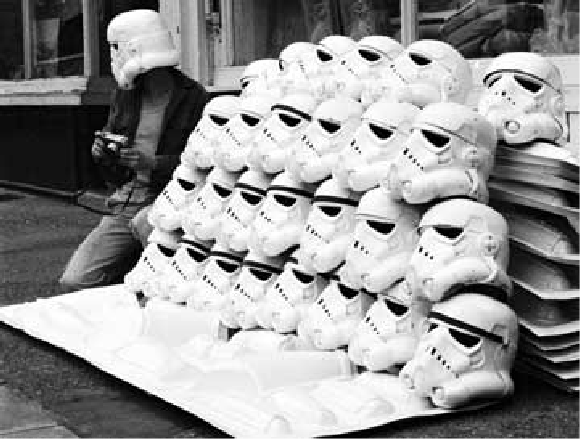
The original HDPE helmets on the pavement at Shepperton Design Studios
Nick asked Andrew to produce 50 Stormtrooper helmets and 40 X wing Pilot Helmets to be invoiced to him. As Andrew had now been introduced to Mollo, it was agreed that if there was any future work, Andrew would deal directly with the Studios and maybe just give Nick 'a drink' for the contact. This Andrew did and they remain good friends to this day.
A week passed and Andrew beavered away using the khaki HDPE material to make the first Stormtrooper helmets as the Studios were in a hurry to get anything and were quite happy to get helmets that were just the same as the prototype. Andrew made about 27 of the helmets in HDPE (21. Picture insert), but had to shot blast and spray them to get them white. Mollo agreed on white as no silver plastic was available at that time. Andrew's plan was to make them in a better quality white ABS plastic at a later stage.
The helmet production progressed, although several modifications were made. Finally 50 helmets were delivered to the Studios along with 40 X wing helmets and Andrew invoiced Nick for the work, still without any form of order or contract.
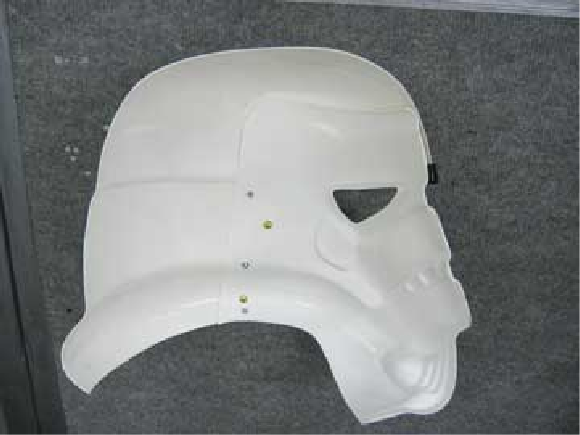
Section through the helmet showing the large undercuts in the design
The HDPE material was difficult to mould and, although it would form large undercuts okay, the shrinkage and distortion when releasing from the mould was terrible. This meant that many of the first batch that went to Tunisia for the desert scenes which were all shapes and sizes. In the end, Andrew made 50 of the Stunt helmets and every one would have been slightly different, so it's only helmets made from the original moulds that will conform to the original screen-
The better quality Stunt helmets came on stream later when the white ABS used for the armour came in. While these did not suffer from shrinkage and conformed to the mould shape accurately, the ABS was more fragile so most of these did not survive. The helmets we make today are from an ABS material that accurately conforms to the original moulds and in addition has an Acrylic high gloss surface that protects the ABS from UV degradation. As Elstree Studios Art Dept. struggles, Andrew is called in to make the Stormtrooper armour in time for the first shoot in Tunisia -
PANIC!!
This was the entry in Nick’s diary from 25 February 1976… Nick was away and Mollo called a rush meeting with Andrew at Nick`s to ask him to attend a meeting the next day at Elstree Studios to discuss the production of the armour.
Andrew met with the production crew headed by John Barry, the Art Director, who explained to Andrew ‘We have been working on this film for three months and all we have to show for it is this’ as he held out one of 3CPO's eyes.
Andrew saw no evidence of any armour being made, but Nick had said that he had seen some grey armour being worked on, probably in the same style as the grey clay helmet from Liz Moore.
In any event, John Barry gave Andrew a further sketch which portrayed a Stormtrooper with canvas type ammo pouches as per a soldier from the Vietnam War. He asked Andrew if he could make the armour in time for the first shoot in Tunisia, less than a month away. Andrew said he could, and the Art Dept. at the Studios abandoned any further work on the armour and moved on to Darth Vader.
Sculpting the armour moulds
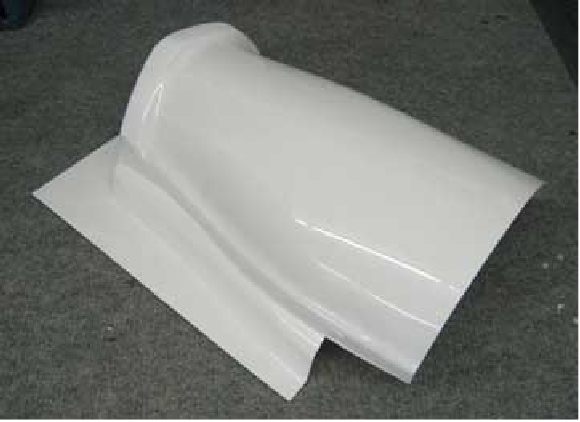
Armour moulding detail.
Andrew set about making the moulds in a completely different way to that of clay sculpting. The moulds were hewed out of the resin/metal composite that Andrew had developed for just that purpose, much the same as a sculpture is hewed out of solid marble. The studios sent over a few useful plaster casts for reference, but they could not be used to make moulds, nor did they in any way constitute a complete set of armour.
Andrew sculpted the moulds to take into consideration the post trimming and assembly. The chemical welding process used for assembly required the parts to be substantial enough in thickness, so Andrew used a double step technique in the mould to stop the material from thinning when vacuum formed.
This could not possibly be conceived from a clay sculpting. You can see more about how the original armour was created in our video, below.
Lucas approves
The armour grew in stages; matching it to himself as the dummy, Andrew cut and remoulded parts and adjusted the moulds until the parts fitted together in a coherent manner. You can see how the armour was made in our video, right.
The 35 mouldings that go to make up the armour were developed over a period of time, with visits to the studios where Lucas vetted the latest developments. Some items, such as the legs, were in fact re-
Five pieces of the armour, shoulders and shoulder bells were recorded as being developed and supplied as late as 5 April 76 (Mollo's sketch book page 329) and other parts of the moulds that were made from wood, bore no possible connection to any clay original.
"I stylised the ammo belt, which had originally been conceived as canvas pouches. Lucas, being a pragmatic director, accepted the new style as it enhanced the overall slick futuristic appearance of the Stormtrooper." Andrew Ainsworth talking about the armour development.
Producing the Armour
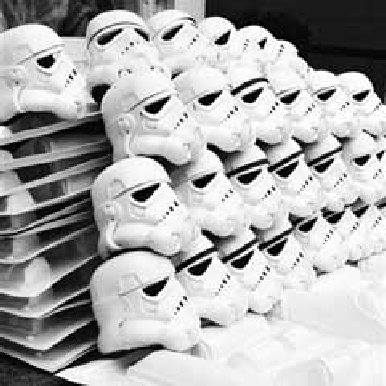
Moulded sheets of plastic cooling on the pavement.
Andrew’s large vacuum forming machine had a 15 ft. x 3 ft. bed that could accommodate all the moulds in one hit. However, the old Sweet Shop in which it was housed was a bit tight for space to say the least. As it was also a little hot, moulded sheets of plastic were turfed out on the front pavement to cool down.
Once a set of moulds had been developed. it did not take long to mould all the armour needed to meet the shoot date in Tunisia, however the initial 'Sandtroopers' were cleaned up a little before the crew came back to shoot the rest of the film. Later Stormtroopers therefore showed slight variations from the first batch.
Andrew made 50 sets of armour in all and as they were quite versatile in fit, they were used over and over again for not only ANH but also the sequels.
Star Wars Memorabilia
After working in the movie props business during the late 70's, Andrew Ainsworth spends the next 25 years successfully designing and producing watersports products. Andrew recalls "We were back in the house in Twickenham which we'd rebuilt after the fire. I was being hassled for school fees (how life changes). On top of the wardrobe were a few remnants of a past era -
ANH props in storage
While at Shepperton Studios Andrew meticulously kept all moulds on racks in an organised manner and all with protective skins moulded and left on them until further use. Andrew explains "We used to sell the same props, or derivatives of, several times over, as new production companies came and went. This was standard practice at all studios and in fact the 'prop stores' are without a doubt the most fascinating insight into movie history. The word `prop` means property. The items we retained from film productions were our property and it was our business to reinvent them or sell them again for the production of lesser movies or maybe ads."
After finishing with the film business and requiring valuable space, Andrew decided one day in the early eighties to have a clear out. Out went the Stormtrooper armour moulds, but he kept the protective skins for reference. He also kept the moulds for the helmets as they were better made, in pretty good condition and possibly one day may have a use.
Dusting down the moulds

We are happy to report that the moulds are in excellent condition after their near 30 year sleep in the props store. They have been well looked after! We have carried out some minor renovation work on the moulds to ensure that the helmets we produce today are as close to the originals as possible. We are confident that our customers will treasure these helmets for years to come.
Andrew continues "We mean exactly what we say 'The Original Maker, The Original Moulds'. I make each helmet by hand using the original moulds* I made in 1976 for ANH. Helmets from us here at Originalstormtrooper.com are truly unique as they are first generation facsimiles of the on-
*apart from the Battle Spec helmet which is partly CNC machined.
Lucasfilm has attempted to discredit Andrew Ainsworth as the original creator of the Stormtrooper helmet moulds used to create the helmets for ANH (read more about how the initial Stormtrooper was chosen here). 32 years on, the source of the initial clay helmet mock-
Lucas chooses his Stormtrooper

George Lucas viewing the Stormtrooper mock-
On 20 January 1976, Nick Pemberton, local scenic artist and colleague of Andrew Ainsworth, went to the Studios and presented Lucas with a red clay helmet mock-
Red clay sculpture identified
Skip forward 32 years to Lucasfilm claiming in court that the red helmet was made at the Studios by Liz Moore and hence all copyright belonged to Lucas. (Andrew knew that Nick always used red clay as it was cheaper...the Studios' art department always demanded the best fine grey clay!) In court, in a short dramatic court statement by Liz Moore's boyfriend (John Richardson), it was established that Liz Moore only ever used grey clay. Lucas' claim was totally dismissed.
Read for yourself the short court transcripts below (statements are directly from the formal court transcript and include the original numbering)
Day 1: 14 April 2008
Mr Richardson, boyfriend of Liz Moore -
4 Cross-
5 MR WILSON: Mr Richardson, you say you recall Liz working on
6 two sculptures in particular for the Star Wars film.
7 A. Yes.
8 Q. Did you visit her on the lot and see her doing it?
9 A. I did, yes.
10 Q. So you saw her sculpting the C-
11 A. I did indeed.
12 Q. Can you remember what sort of clay she used for doing
13 that?
14 A. Grey.
15 Q. Can you remember what clay she used for the Stormtrooper
16 helmet?
17 A. She always used grey clay. Everything I ever saw her
18 model was in grey clay.
19 MR WILSON: Thank you very much, Mr Richardson.
20 MR BLOCH: I have no re-
21 MR JUSTICE MANN: Thank you, Mr Richardson. You may think
22 your journey was hardly necessary but thank you very
23 much for coming.
24 A. Thank you for dealing with me, sir.
25 MR JUSTICE MANN: Right.
Day 2: 15 April 2008
Following Mr Richardson's dramatic statement, the case before Mr Justice Mann continued the following day, 15 April 2008.
13 MR BLOCH:(Counsel for Lucas) My Lord, in the light of the evidence given by
14 Mr Richardson yesterday, we no longer seek to establish
15 that the red clay sculpture was made by Liz Moore.
16 The next witness will be Mr Gary Kurtz.
17 MR JUSTICE MANN: Would you give me a moment? My computer
18 is now obstructing me. (Pause) Yes, I'm sorry,
19 Mr Bloch. Just before we move on to that, you are no
20 longer saying that that sculpture was Liz Moore's
21 sculpture?
22 MR BLOCH:Yes.
23 MR JUSTICE MANN: Are you able to tell me how the witness
24 was allowed to go in the witness box with his witness
25 statement in the state in which it was when one
1 straightforward question simply demolished the whole
2 purpose -
3 the whole purpose -
4 able to tell me that or is that all privileged material?
5 MR BLOCH: It is privileged material and it's also something
6 which I have not discussed with those who were involved
7 with the preparation of the evidence in any depth, but
8 the evidence came as a surprise to me and I believe also
9 to them.
10 MR JUSTICE MANN: Right. Well, there it is.
Lucas authenticates the armour
As well as the helmets, Lucas also initially questioned the authenticity of SDS armour and supplied Laela French from the Lucas archives to act as an expert witness.
The night before the hearing, both sides laid out their respective sets of armour in court and both barristers Mr Bloch QC (Lucas) and Mr Wilson QC (Ainsworth/SDS) inspected the respective sets of armour.
Later that evening (23.06 pm, 8 April 2008), the SDS camp received a formal letter from the Lucas camp which read:
Dear Sirs.
We are writing to confirm what was said by Mr Bloch QC to Mr Wilson QC this evening, namely that we will not be seeking to establish for the purpose of these proceedings that the dimensions and design features of the replica props being produced by the Defendants, differ in any material respects from the props which Mr Ainsworth produced for Star Wars: a New Hope, and that consequently we will not be calling Ms French.
Yours faithfully…
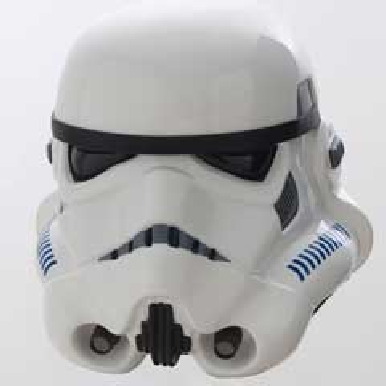
A helmet from Original Stormtrooper
Andrew Ainsworth notes "I rest my case. Even to this day, some Lucas followers try and suggest that the red clay was sculpted at the film studio. I hope the exposure of the court evidence dispels this myth once and for all. It's clear that my colleague Nick created the red clay mock-

In 2004, Andrew Ainsworth at Shepperton Design Studios began producing and selling replica ANH Stormtrooper helmets. Each helmet was handmade by Andrew using the original moulds that he'd kept in his prop store since they were first used to make the on-
Lucasfilm sued Andrew in the United States and a California court awarded $20 million in damages against him. Andrew did not have the means to defend the case, recalling that "taking on Lucas on his home patch is not a good idea". The upshot was that Andrew stopped selling his Stormtrooper helmets in the US.
Lucasfilm then looked to enforce the American copyright ruling in the UK and brought the case to the High Court in London. After an appeal in The Times (read online here), Andrew received offers from leading barristers to represent him in the case.
To cut to the chase, the case went to appeal where Lucasfilm failed to enforce its US copyright in Britain and Lucasfilm's appeal was dismissed in December 2009. Andrew Ainsworth won each of the copyright claims made against him leaving him free to continue producing and selling his authentic replica helmets in the UK, Europe and the rest of the world excluding USA.
Reproduced with the permission of Andrew Ainsworth – May 2016
A fascinating story and who would have believed it? It is also a very important lesson to be learned by creative people from all disciplines. How often have those famous words, “if I knew then what I know now”, have been uttered in despair.
To be philosophical; every creative person must always remember those immortal words:-
Andrew’s story is not only remarkable but indeed a very common story. Back in 1976 would Andrew ever have believed that 40 years later his creation would be one of the best known faces on Earth and perhaps even more well-
The answer of course is NO. As Andrew said, when the opportunity arose they got ‘stuck in’ and came up with original ideas. At the time they had no idea what the future would hold and frankly George Lucas himself had no idea.
To end up with a $20 million claim for damages is a sad end to that long journey but fortunately, as in Star Wars, the final chapter was a happy one for Andrew.
The moral of the tale is simple. Your first step is to plan your journey and work with those who can and will give you unbiased guidance.


A CENTURY OF SUPPORT
FOR
A CENTURY OF IDEAS


CASE STUDY 1

A selection of case studies